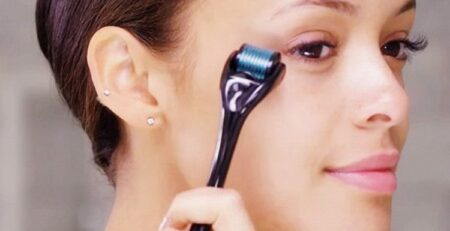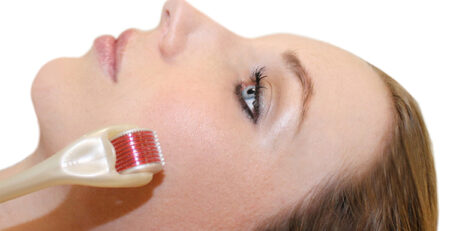Is Dermarolling Therapy Effective For Treating Chicken pox or Varicella Scars?
Varicella or Chickenpox is a common viral disease which is caused by Varicella zoster virus.[1] Having a scar after the infection is also common and this poses a cosmetic concern. Like other types of scars, varicella scars are difficult to treat.
There are only few treatment modalities available to treat atophic varicella scars. One of the available treatments is trichloroacetic acid or TCA which is used for dermal collagen remodeling. 1 It is also called CROSS technique or Chemical Reconstruction of Skin Scars. It is a cheap, safe and effective therapy for post varicella scars.
Other effective treatment modalities used to treat cutaneous scars are laser treatment,3 although, laser treatment is a bit expensive compared with the newer technique like microneedling therapy.
Another new treatment modality that is being used to treat various types of scars is Dermarolling therapy. It is also known as Microneedling Therapy, Percutaneous Collagen Induction or PCI and or simply skin needling. Initially, dermarolling therapy is used to treat cutaneous depression, but now this treatment modality has expanded and is now being used in various dermarologic conditions. [2]
Before it was only being used to treat scars and wrinkles. Now, dermarolling therapy is used in wide array of skin conditions. It is used to reduce and or eliminate:
- Fine Lines
- Stretch marks
- For Facial rejuvenation
- Transdermal drug delivery
- Alopecia or arrest of hair growth
- Acne Scars for all skin types
- Cellulites
Dermarolling therapy has been deemed safe and effective to treat these skin conditions. It is also cheaper compared with other conventional treatment.
So, What is Varicella?
Varicella or commonly known as Chicken pox in the United States is caused by a virus called Varicella zoster. It is regarded as a mild and self-limiting viral illness. Varicella is highly contagious and it commonly affects children and young adolescents. A common effect of varicella is post scarring which causes multiple round and crater like depressions.
Is Varicella Scars Challenging To Treat?
Varicella scars is always a challenge to treat. Dermatologist always finds difficulty on how to treat atophic scars even if it is caused by other etiologies. 1 In addition, there are some young children who develop hypertrophic scars and keloid scars after chicken pox infection. [3] Although, it is rarely reported after having varicella, but it is not far from happening.
How is Dermarolling Therapy Being Done?
The Percutaneous Collagen Induction therapy uses a cylindrical device which is composed of sterile micro needles that are rolled in various directions. When used, it creates several micro puncture through the epidermis until the dermis. It creates a multiple cutaneous injuries that break the old strands of collagen.
This creates a cascade of events that would eventually activate the growth factors that will stimulate the proliferation and migration of fibroblasts. It will then result to production of collagen. This treatment modality creates an intentional micro injury to reduce the scars in the area.
How Microneedling Removes Varicella Scars?
In a case study of Costa and Costa in 2014, they had an adolescent black-skinned patient with previous history of varicella scars when she was 3 years of age. The patient had multiple round scars, crater-like around 0.5 cm in diameter which is found on her forehead and cheek. She had three microneedling sessions with one month interval each.
A disposable dermarolling device was used with 20 mm wide cylinder which contains 192 microneedles at 1.5 mm long and 0.25 in diameters. A topical anesthesia cream was applied on the affected areas, an hour before the treatment. There are around 10 horizontal, vertical and oblique passes were done on the areas with scarring. 2
As commonly observed in microneedling treatment, superficial bleeding was noticed in the skin area. After the treatment, there was a temporary erythema which was observed for seven days. Then, a week after the transient erythema disappeared spontaneously and completely. No other complications were observed during or after her treatment sessions.2
After several sessions, there was a significant improvement in her varicella scars. 2 The multiple round and crater-like scars was completely gone. She also had a smoother and fairer complexion. There was no any pigmentation noted even if the patient has a black skin. Usually, pigmentation problem is commonly observed among dark-skinned individuals who undergone conventional treatment.
It is a good thing that in microneedling therapy, there was no any pigmentation observed.
The Challenge in Treating Varicella Scars
Atophic scar caused by varicella is disfiguring. [4] Scarring is a result of an exaggerated response to wound healing following an insult to the skin. More so, scars also present as a cosmetic concern. It can also be itchy and painful at times.
Scars are particularly bothersome if it is found on the visible areas of the body particularly in the face. Having a crater like and multiple round scars can be a cause of lower self-esteem particularly among adolescent.
Hence, microneedling therapy is a great addition to the new treatment armamentariums. Patients now have wide array of choices as to which treatment they would like to undergo. They can also choose which treatment they like based on their budget.
Even if they choose lower price treatment modality, they can be assured that the outcome is as effective with the expensive conventional treatment.
Dermarolling Therapy is the New Treatment for Varicella Scars
The new clinical studies have proved that dermarolling therapy can be used as a treatment for post varicella scars. As to the patients case, even if she had her scars at 3 years of age, the dermarolling therapy was still able to remove the atophic varicella scars. This showed that indeed dermarolling therapy can be used safely and effectively to remove chickenpox scars.
Bibliography
[1] Agarwal N1, Mittal A, Kuldeep C, Gupta LK, Khare AK, Mehta S. (2013). Chemical reconstruction of skin scars therapy using 100% trichloroacetic Acid in the treatment of atrophic facial post varicella scars: a pilot study. J Cutan Aesthet Surg. , 144-7.
[2] Costa, Izelda M. C. PhD1; Costa, Mariana C. MD2. (2014). Microneedling for Varicella Scars in a Dark‐Skinned Teenager. Dermatologic Surgery , 333–334.
[3] Kluger N1, Mahé A2, Guillot B3. (2011). Eruptive keloids after chickenpox. Dermatol Reports.
[4] Alster TS1, West TB. (1997). Treatment of scars: a review. Ann Plast Surg. , 418-32.














